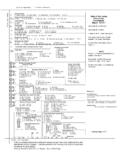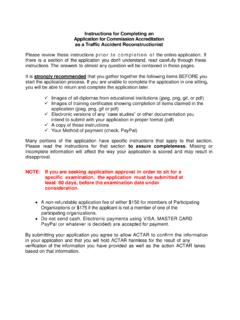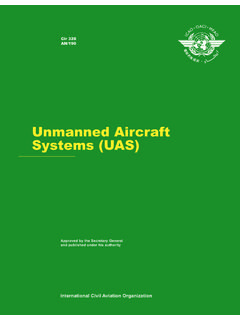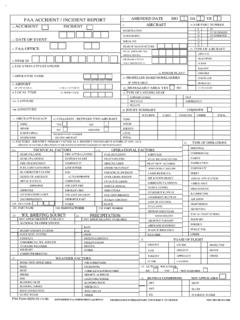Transcription of Guide for Determining Preventability of Motor Vehicle ...
1 Guide for Determining Preventability of Motor Vehicle Accidents (Based on National Safety Council Rules) PREVENTABLE ACCIDENTS A Preventable Accident is one in which the driver failed to exercise every reasonable precaution to prevent the accident. This is irrespective of whether or not there is property damage or personal injury, the extent of the loss of injury, to whom it occurred and the location of the accident. In order for a person to avoid being involved in a preventable accident, each driver should understand and practice the concept of defensive driving. Defensive driving is driving so as to prevent accidents in spite of the incorrect actions of others and adverse driving conditions; such as light, weather, road, traffic, Vehicle condition and your physical and mental state.
2 In interpreting this, the National Safety Council lists the following preventable accidents: 1. INTERSECTIONS It is the responsibility of all drivers to approach, enter and cross intersections prepared to avoid accidents that might occur through the actions of other drivers. Complex traffic movement, blind intersections, or failure of the other driver to conform to law or traffic control devices will not automatically discharge an accident as not preventable. Intersection accidents are preventable even though the driver has not violated traffic regulations. Failures to take precautionary measures prior to entering the intersection are factors to be studied in making a decision. When a driver crosses an intersection and the obvious actions of the other driver indicates possible involvement either by reason of excessive speed, crossing the lane in turning, or coming from behind a blind spot, the decision based on such entrapment should be preventable.
3 2. Vehicle AHEAD Regardless of the abrupt or unexpected stop of the Vehicle ahead, a driver can prevent rear-end collisions by maintaining a safe following distance at all times. This includes being prepared for possible on the highway, either in plain view or hidden by the crest of a hill or the curve of a roadway. Overdriving headlights at night is a common cause of rear-end collisions. Night speed should not be greater than that which will permit the Vehicle to come to a stop within the forward distance illuminated by the Vehicle s headlights. 3. Vehicle BEHIND Investigation often discloses that drivers risk being struck from behind by failing to maintain a margin of safety in their own following distance. Collisions involving the rear of the Vehicle , which are preceded by a roll-back, an abrupt stop at a grade crossing, when a traffic signal changes, or when the driver fails to signal a turn at an intersection, should be charged as preventable.
4 Accidents resulting from the failure to signal intentions or to slow down gradually should be considered preventable. 4. PASSING Failure to pass safely indicates faulty judgment and the possible failure to consider one or more of the important factors a driver should observe before attempting a maneuver. Unusual actions of the driver being passed or of oncoming traffic might appear to exonerate a driver involved in a passing accident; however, the entire passing maneuver is voluntary and the driver s responsibility. 5. BEING PASSED Sideswipes and cut-offs involving a driver being passed is preventable when the driver fails to yield to the passing Vehicle by slowing down or moving to the right where possible. 6. ONCOMING It is extremely important to check the action of a driver involved in a head-on or sideswipe accident with a Vehicle approaching from the opposite direction.
5 Exact location of vehicles prior to and at the point, should be carefully verified. Even though an opposing Vehicle enters a driver s traffic lane, it may be possible for the driver to avoid the collision by slowing down, stopping or moving to the right. Failing to signal the opposing driver by flashing the headlights or sounding the horn should also be taken into account. 7. FIXED OBJECTS Collisions with fixed objects are preventable. They usually involve failure to check or properly judge clearances. New routes, strange delivery points, resurfaced pavements under viaducts, inclined entrance to docks, marquees projecting over a traveled section of road, and similar situations are not, in themselves, valid reasons for excusing a driver from being involved in an accident.
6 A driver should be constantly on the lookout for such conditions and make the necessary allowances. 8. PEDESTRIANS Since a driver of a Motor Vehicle has the responsibility to yield the right of way to pedestrians, primarily due to their vulnerability to injury when involved in an accident, most pedestrian accidents are preventable. An unusual route of a pedestrian at mid-block or from between parked vehicles does not relieve a driver from taking precautions to prevent such accidents. Whether speed limits are posted or the area is placarded with warning signs, speed may be too fast for conditions. School zones, shopping areas, residential streets, and other areas with special pedestrian traffic should be traveled at reduced speeds equal to the particular situation.
7 Bicycles, Motor scooters, and similar equipment are often ridden by young and inexperienced operators. The driver who fails to reduce speed and increase side space cushions when approaching this type of equipment has failed to take the necessary precautions to prevent an accident. When unusual conditions call for voluntary reduction of speed, merely keeping within posted speed limits is not taking the proper precaution. 9. PRIVATE PROPERTY When a driver is expected to make deliveries at unusual locations, constructions site, etc., or on driveways not built to support the weight of the Vehicle being driven, it is the driver s responsibility to discuss the operation with the proper authorities and to obtain permission prior to entering the area.
8 10. PASSENGER ACCIDENTS Passenger accidents in any type of Vehicle are preventable when they are caused by faulty operation of the Vehicle . Even though the incident did not involve a collision of the Vehicle , it must be considered preventable when a driver stops, turns, or accelerates abruptly. Emergency action by a driver to avoid a collision that results in passenger injury should be checked to determine if proper driving prior to the emergency would have eliminated the need for the evasive maneuver. 11. NON-COLLISION Many accidents, such as overturning, jack-knifing, or running off the road may result from emergency action by the driver to avoid being involved in a collision.
9 Examination of events prior to the incident may reveal speed too fast for conditions, or other factors. The driver s actions prior to involvement should be examined for possible errors or lack of defensive driving practice. 12. MISCELLANEOUS Projecting loads, loose objects falling from the Vehicle , loose tarpaulins or chains, doors swinging open, etc., resulting in damage to the Vehicle , cargo, or other property or injury to persons, are preventable when the driver s action or failure to secure them are evidenced. Cargo damage, resulting from unsafe Vehicle operation, is preventable by drivers. 13. PARKING Unconventional parking locations, including double parking, failure to put out warning devices, etc., generally constitute evidence for judging an accident preventable.
10 Roll-away accidents from a parked position normally should be classified as preventable. This includes unauthorized entry into an unlocked, unattended Vehicle , or failure to properly block wheels or to turn wheel toward the curb to prevent Vehicle movement. 14. BACKING Practically all backing accidents are preventable. A driver is not relieved or responsibility to back safely when a Guide is involved in the maneuver. A Guide cannot control the movement of the Vehicle ; therefore, a driver must verify all clearances. CONCLUSION It is impossible to describe in detail the many ways a driver might prevent an accident without being primarily or legally responsible. The paragraphs of this Guide merely emphasize the most frequent occurrences based on past decisions of the Accident Review Committee.







